Page one - Sri Radha Gopijanavallabha, and assorted Shilas
- March-April 2001
Page two - Close-ups June 2001
Page three - New Additions, "group photo"
- February 2002
Page four - HERE
.jpg)
HH Bhaktisiddhanta Swami
After several years of worshipping the Lord in His shaligram sila form, last February was an opportunity to go visit a few of His Home's on the Kali Gandaki in Nepal, from Jomsom, Kanbeni (Kagbeni) up to the famous Muktinath which is 1000 meters above the sacred winding tributary of millions of Supremes. Anyone who goes or has gone will remember this experience as one of the highlights of one’s life. It is so humbling to have darshan of this unequaled setting of the Lord’s virat rupa of changing skies, snow capped mountains, and serene townships along the Kali Gandaki providing a constant abhisheka of the Lord in one of His ‘most personal and unique forms’.
Everyone who visits may have a different time schedule which will determine how long and where you will go. Remember one trip will invite repeated visits. Our journey was a 12 day affair leaving and returning to Vrindaban. If one is going to search for Shaligrams then 5 days or so in the mountain areas is plenty for ones full satisfaction in finding Lords along with the demanding exercise involved in looking.
Firstly, I flew round-trip from Delhi to Kathmandu which cost $290 US (I went alone...no one else could come) Foreigners pay full fares on these routes. If you have an Indian body the ticket will be around $150. We were blessed with some Maoist uprisings in Nepal, a problem just in certain areas between the government and rebels which brought no danger to tourists but in reality scared most away. This was nice…less people and more nature. Generally February thru' to September can be busy times.
In Kathmandu, apart from the temple, is an area called ‘Themal’ where the foreigners all go. It is protective here and provides all kinds of camping and travel accessories that you may need. The prices in Nepal are 1/3 what you find in the west with all the name brands. One can rent a warm jacket or sleeping bag for around 25 Nepali rupees a day, eliminating useless luggage as you visit the dhamas. We spent a few days there which helped with any needed altitude adjustment.
Around the neighboring Buddhist temples like Pasupatinath (near the airport) and market places many Shaligrams are available and of course it is an offense to place a price or sell a shaligram but there is no harm if they are given to one as a gift.
Our schedule was to fly the sectors between Kathmandu-Pokhra-Jomsom by plane (around $60 USD each sector times 4 plus $28 for the required hiking permit, airport taxes…approx. $300). This way we could use all of our available energy for searching. If one is fortunate to have more time then walking these routes takes 3-5 days. Arrangements can be made for horseback excursions also.
The flight from Kathmandu to Pokhara (35 minutes) is on a 40 seater plane and the one to Jomsom is a 24 seater. This is a change for in the past they used to have a 12 seater nicknamed the ‘vomit express’. I know on the Jomsom leg Indradyumna Swami once had a rare but interesting upside down view from his window of the area just before landing. But now with the bigger planes the ride is quite stable and tolerable. In Pokhara the place to go is ‘Lakeside’. Here with lake views and the backdrop of snowy mountains is your first glimpse into a reality. Again you will find the lodging and whatever hiking supplies one may need. Many Shaligrams will be visible in the market area.
.jpg)
.jpg)
Riverbank towards Jomsom
.jpg)
Cold Feet from being in the icey cold waters of the Kali Gandaki
.jpg)
Supplies on
the way to Jomsom
.jpg)
Where to look for silas
.jpg)
Up the Gandaki
gorge towards Kan Beni
.jpg)
Kan Beni...best
apples in the world
.jpg)
Kan Beni bridge...........swings
with the wind
.jpg)
View downstream
from bridge
.jpg)
Looking down
towards Kan Beni from first leg of climb to
Here is a list of items (if you are going to stay in a lodge) that should be taken (at least for February-March)…April through to September is warmer.
1 thermos (for herbal teas and hot milk (powdered milk provided at the lodges)
2 warm apparel (long underwear, hat etc.)
3 gloves
4 gum boots (water resistant for wading through the water)
5 muesli mixes, nut bars etc…
6 candles (occasional lighting needs and can even give a little warmth which can soften the morning brisk air within ones room)
7 map (available in Pokhara and Kathmandu…......good quality and inexpensive)
8 goggles (high winds…sand and glare in the glacier areas)
9 camera (your crazy if you don’t record the trip for the others)
10 basic shoes for climbing (if you stick on the main trail you won’t need hiking boots)
11 Decent backpack with suitable pockets to hold essentials
These panoramas need to be viewed on a 17inch screen minimum
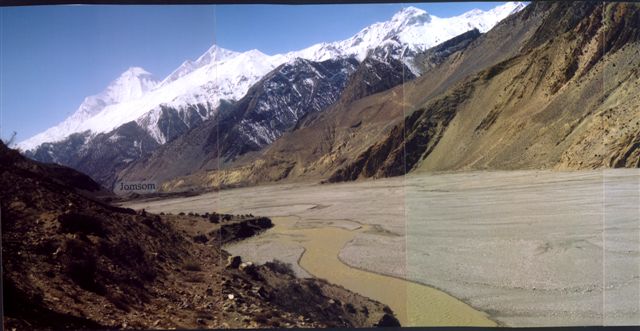

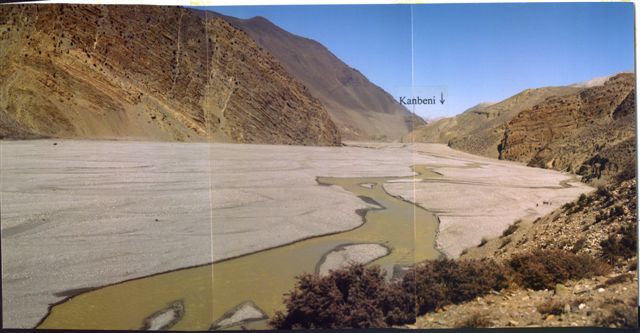
A pan of the Kali Gandaki with Jomsom to the left and Kan Beni to the
right.
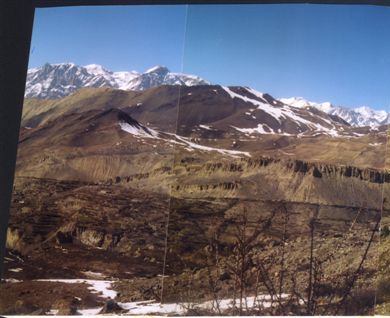
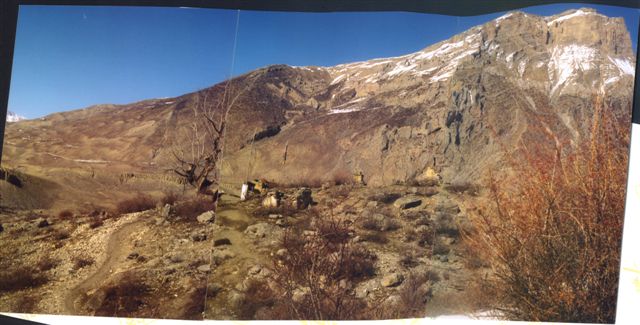
Then walking from Jomsom to Kanbeni (Kagbeni) (2½ hour hike…8 hours for river enthusiasts) then a later trek up to Muktinath (2½ -4 hours depending one abilities in the high altitudes…an elevation of a mere 3,800 meters) and then half the time in reverse. Quaint lodging facilities are in each area for $1 to $2 US dollars a night. I found it advantageous to rent rooms in all 3 locations leaving Shaligrams and personal items that would aid to light traveling between the sectors… and of course you can't beat the prices.
Muktinath
.jpg)
To left 500
meter drop below
.jpg)
First bend on
climb...........you still have a long way to go
.jpg)
Just below Muktinath...you
still have a long way to go
.jpg)
Winding path
up to Muktinath.............you felt like cursing each boulder obstacle
.jpg)
Town of Muktinath.............Finally!
.jpg)
Pilgrims on
the path - local Tibetans selling their wares
.jpg)
Donkey supply
train can go up too
.jpg)
Small horse
(full grown)...............come up to your ankles

View of AnnaPurna
Range from upper muktinath
.jpg)
Muktinath Laxmi
Narayana Temple
.jpg)
108 spouts at
Temple..................great shower for fanatics
.jpg)
Evening clouds
in Muktinath
.jpg)
Muktinath sunset
over AnnaPurna Range
Leaving the Kali Gandaki at Kanbeni (Kagbeni) to climb up to Muktinath is a highlight. I felt that it was maya to leave the Gandaki to go into the mountains but I was wrong. As one ascends you reach plateau after plateau where you think that you have reached the summit, but it just keeps on going. Because of the altitude and our physical state we had to rest 35 times on the way up (sometimes after every 100 steps) and only 3 times on the way down. You were cursing the person who made these large stone stairs at the closing intervals (almost like a malicious test). Finally you do reach the town of Muktinath and above the town (another 45 minutes) is a Laxmi-Narayana temple built in a glacier (from where the mountain pan is taken). There are 108 shower spouts coming from the glacier on the back wall of the shrine with the best water that makes the journey a complete success (some fanatical devotees even shower there). We spent one night in Muktinath and even though 1000 meters higher than Kanbeni was warmer because the high winds on the river level make it more austere. To our surprise many special Shaligrams were found and given to us by different pilgrims on the path downward.
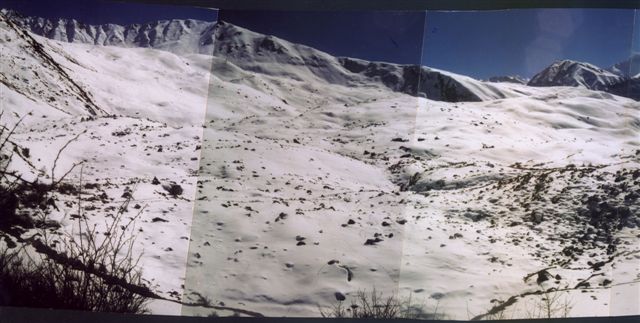
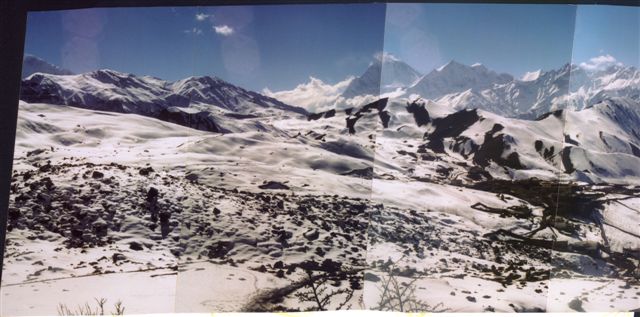
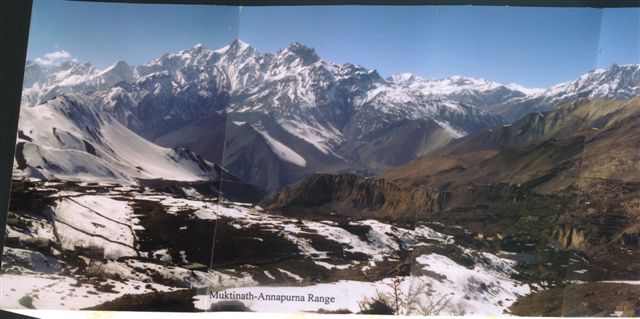
A beautiful view of from Muktinath of the Annapurna Range
What adds a cultural mystique to the mountain paths and the flat areas of the Kali Gandaki are the teams of yaks and mules that would traverse the steep slopes carrying supplies back and forth from each area. The owner would be behind a team of 6 or more animals that methodically climb and descend (they could probably have done it blindfolded), stepping out of the way of persons who would approach from the opposite way. Each would wear an enchanting bell (like one of those wind chimes) which would create a sattvic atmosphere, especially needed when you round a sharp corner on a narrow path and if without the bell… without a warning…well you tell me…you are quietly rounding a blind corner bend over a 500 meter canyon and suddenly you come nose to nose with a large personality with long horns…how would you react? So the bells do provide tranquility and safe travels. On the pan of the Gandaki you will note on the bottom right-hand side of the picture a tiny line of such a team sauntering along. This gives you an appreciation for the vastness of the area.
One can note that the area north of Kanbeni is known as Mustang which is a no man's zone and is a buffer area to the Chinese boarder. It is illegal for foreigners to go into this region and your trekking pass does not allow entrance there. This area is less traveled and leads after many kilometers to the well known Damodar Kund which is one of the quarters where the Shaligrams originate. There are many here that may be a little rougher than those found in the other areas of the Kali Gandaki. They become smoothly featured as they are brought southward through the naturally winding concourse leading down to Beni. This Kund can be accessed as long as you are accompanied with a government guide and a painful permit of $1000. HH. Indradyumna Swami once took a helicopter to this hidden site. You would have to ask him Who he found. The Tibetans and sadhu’s can travel here freely and I know one devotee in Vrindaban who has the proper physique and wants to venture up there as a local sadhu and pray for the Lord’s special darshan.
We crossed the boarder of this no mans land in the Mustang area for one kilometer only. It wasn’t worth attracting unnecessary attention on such a smoothly running trip. Many years ago Aindra das had gone deep into this area and the police with attack dogs came all the way around the mountain thinking that he was a spy and coerced him to go to the police station for an interrogation with the barking dogs nipping at his heels as he stumbled along carrying a large burlap bag of Lords. Everything was straightened out but the realization was that there was no point in flaunting the laws of the land. Actually during my stay in this region I met a leading member in parliament for foreign relations and human rights who is trying to open up the entire Mustang area for tourists. This covers miles of the Kali Gandaki where only the natives can go to find Shaligrams and who then bring Them to the metropolitan districts.
Next we went back to Kanbeni for one night to repack
and then to the Jomsom area and the airport. The return walk was much quicker.
Having found so many Shaligrams we had no desire to further agitate the
mind with ‘Who is where’, but just the feeling of ‘enough is enough’. At
our hotel we could look at Everyone and see Who wanted to go and Who wanted
to stay. Many Shaligrams were duly returned to the Kali Gandaki.
Searching Tips and Highlights
In looking for the different Shaligrams, one will notice that they will be sporadically found amongst the many river stones. Some would be clearly visible
by color and others would be covered by a whitish film or calcium coating and would have to be brushed and rinsed. A well known approach to find Shaligrams apart from proper consciousness is to actually hold a shaligram in the hand… They attract Each other.
This mantra should be recited again and again:
dheya sada savitra mandala madhya-varti
naryanah sarasijasana sannivistah
keyuravan makara kundalavan kiriti
hari hiranmaya vapuh dhrita sankha cakrah
Narayana is the Supreme Personality of Godhead to be meditated upon in the center of the sun globe. He is situated on a lotus flower and seated in the lotus posture. He is adorned with beautiful golden bracelets, amulets, earrings, necklace and a crown. He has the golden effulgence and is seen holding the pure white conch and Sudarshana cakra in His lotus hands. Oh wielder of the conch, disc, club, and other natural weapons, You are the Lord and resident of the spiritual realm. Oh indestructible one, protector of the worlds, oh lotus eyed Lord, please save all of us who have taken shelter of you and appear before us…...
One will notice that many times the silas will manifest in veins or sections at a time. I spent most of my time searching along the waters edge in the banks of the river on the sides and the middle parts where the water has carved away giving a clear view of many layers of silas. Here one can also sift through the bank and find hidden Shaligrams. I wore these rubber gum boots because one has to wade in the water sometimes crossing the river at shallow points. The whole affair became quite hypnotic looking everywhere at stones and pebbles with the intermittent Shalagram here and there, searching for faces and at night in dreams the activity was the same.
Apart from the above mantra another more personalized one drew some attention. “This place is freezing …would Anyone here like to come to the west for warm baths, curd steaks, chips, sweet rice and burfi?” After such a select beckoning prayer was presented it did not fall on deaf ears….at this point some very special Silas came forward.
One unique Sila, a blue Nrsimha Sila whose long slanting head and open mouth manifested, sitting perched within the wall of one of these banks (reminded me of some pillar pastime). Later a green Sila, rather plump with one circular ring around the top also with open mouth manifested and turned out to be Matsya. Occasionally a perfectly round could be found amidst the clusters of river stones. At times you would not be able to find Anyone and then on occasion there would be thousands.
Leaving Nepal…The Final Test
Generally when leaving the country the policy for customs is that sadhu’s can take a few Shaligrams with them. The main concern for these officials is that persons don't take large amounts of Shaligrams out for fear of the selling ventures that could happen as a result. Technically the Shaligrams are viewed as geological fossils.
My realization was that the final hurdle to leave the country was based on ones entire attitude in relating with the residents during one travels. If Krsna wants to make His appearance that is His mercy. If He also wants to leave the country then no one can stop you. If on the trip you respect the pilgrims in the area (His parts and parcels) then the Lord may make special arrangements.
At one hotel in Jomsom one Indian pujari from Puri had to leave behind one giant Sila around 70 kilos in the hotel water fountain because the officials at the airport would not allow such a Passenger on the plane due to weight restrictions. Maybe he should have spent mere $60 dollars and purchased a seat for this Person. This man did say that he will return someday… probably to bring the Lord down by horse back.
My situation was not as obvious as his but somehow or another we had 250 Shaligrams (many of which were to be given later to those who are already worshipping), large and medium sized to small which collectively could have raised a few eyebrows…what to do. Our best course was to place most of the small round ones (70) in a brand new sock which was then inserted into a thermos, part of my carry on. The larger Silas were either carefully wrapped within my sleeping bag and various small boxes within the check on. Also I had this anglers vest which had around 20 pockets which could come in handy for any surplus Personalities.
At the entrance to all the airports because of the conflict with the Maoist Rebels the government placed soldiers to frisk and search all who entered. Fortunately at the hotel (Moms Hotel) that I stayed in, a boy who lived there also worked for the airlines and as we passed through the military check point I was ushered through. Most of the Shaligrams had to be taken as carry on because checked baggage was limited to 15 kilos.
Because the metal detectors were dysfunctional a body and bag search was required to get into the gate area. In order to keep the officer absorbed I placed the heavy bag onto his table and before he asked started to show him most of the contents within glorifying what we had. “Tooth brush, tongue scraper, camera, gloves…flashlight”. He looked at me quizzically thinking ‘Oh a very excited monk’. He also began to enjoy the rasa and overlooked two aluminium cases that had 25 Shaligrams in them, but he did pick up the thermos which for some reason was very heavy and said “What do we have here?”. In the spirit of the entire exchange I opened the thermos and pointed to the bulging sock of Shaligrams inside and said… “Thingy!” (which is a generic Australasian expression for an item of interest). With a quick peek inside the officer responded in full agreement and said “Oh …yes…” and motioned me through.
As the plane took to the air with the Gandaki and millions of Silas shrinking in size, jaw-like mountain peaks passing by, outstretched rugged woodland below and then all vanishing…it was like an entrance to and exit from a spiritual time warp. One could not help but appreciate the special mercy that has been allowed, a relationship, a friendship and closeness with such a place followed by… a desire to return.
Our next challenge was the customs at Pokhara which went well also but the real test was to get through the customs at Kathmandu in leaving the country. Again the metal detectors were inoperative so everyone was frisked as part of the screening. I was thinking how we had come all this way….we were so close to completing our goal. By Their mercy many Lords had been found. Will They allow Themselves to be carried out (in reality They are the carriers)? Our consolation was simply if Krsna wants to go then nothing can stop Him and if He doesn't want to go then that is His Mercy also. Back up plans were in our mind that if need be to return to Delhi by bus if there is a problem etc. One thing was for sure it was nice time to pray.
The previous histories went through our mind where the officials would sometimes allow devotees to take Shaligrams out of the country and at other times not. What a meditation…the anxiety of a transcendental smuggler. Ok… well what's going to happen next?
The first security guard felt something round underneath my shirt (the multi-pocketed angler vest) and said “What's this”. With a little effort I pulled out a Matsya Sila with edges like a samosa and he exclaimed “Oh shaligram! ” and lets me go…He then breezed through my bags with no real concern. Nectar. It seems that this is the final check point. I can't believe it…everything is going on so effortlessly. We had finally made it to the gate and now all we had to do was walk out to the concourse and get onto the plane.
As our flight # was called it was time to go through the gate down the stairs and then wait in line as… people were….being searched again… as they boarded the plane. This was too much. So close but so far. To speed up the process two lines were made. On the left the main customs agent was posted and on the right a female officer. As the line shortened with my turn approaching, I noticed that this one Swiss gentleman was stopped by the senior customs official. A billiard ball was confiscated from his bag and placed on the floor not to be returned. I guess they were looking for anything that could be used as a weapon on board. Here I was 75 steps from my seat, heart thumping, with the final customs troll standing before me, an innocent skinny monk, armed with a complete arsenal of ‘spiritual Weapons’. Then the female officer waived me over to her table and began to thoroughly search my bags. The aluminum containers that were missed at the previous airports became an immediate curiosity for her. Again the famous question “What's in this?”. She reached into one box and pulled out Lord Nrsimhadeva (He was on His way to the Melbourne temple) Who was certainly bigger that a billiard ball and had a fine combed mane adorning His head. I said “Shaligram”. She looked worried and shook her head. She then held the Lord out giving an unforgettable darshan to the senior official who stood behind me with all kinds of contraband items at his feet and she said “Shaligram…can he take These on the plane?” He scrutinized the Lord and then looked at me up and down (all glories to Vaishnava dress) and said “Its Ok” and motioned for me to go up the stairs…Mission accomplished. The Lords have given Their sanction to come…That was the most comfortable plane seat I had ever sat in, a perfect place to take the ‘Weight’ off your feet.
Distributing and Receiving
By Their design a wonderful victory was at hand. Our previous exposure to the worship of the Shaligram was with out any experience or knowledge of Their home and land of play. It was satisfying that They had not only made Their appearance within our limited world but had chosen to extend Themselves to others in different lands. In other words by Their mercy one can become a medium by which They can enter the life of another. Some individuals have desired to worship the Lord in His Shaligram Sila form but have no access to Them and can not visit the Kali Gandaki personally. They have however desired and prayed for the Lord to come. The deity arranges a maze of avenues to reach the beckoning sadhaka. Just like in book distribution the deities in the form of books will search out and find an individual, who may even be a third party, but is ready and through the domino effect of ‘special arrangements’ the bhakta is found. Personally I was wondering why I had acquired so many Silas (my anticipated plan was 30 at most). So what happened?
As hind sight is easier than foresight an understanding of why was clear. Krsna had His plan to enliven His dependents with opportunity of service. This was the major current of His agenda while our own wave-like motivation was basically limited to the ‘ultimate taste’ in the giving of the Shaligram to another. And of course, I wouldn't want to omit that our motivation could have also involved the consolatory prize of the possibility of worshipping a number of Lords.
Plane travel always means that the Lords are physically with you. However, in these circumstances many were in the check on baggage. So despite the wonderful triumph, things were not over yet. Who has not had that uncanny feeling as you wait in the airline baggage terminal pondering is it going to me to lose my luggage this time? Most the people have been happily reunited with their belongings and you have to be amongst the few scanning the rotating rubber belt as it stops and starts. Do you remember that punch in the gut feeling when the belt stops and you are the last one around? And by the way you just happen to be in India! Well at least this trip to the Delhi airport did not end in this way, but these thoughts were still crowding my mind. The ecstasy of seeing that ‘back pack of Lords’ finally come into view closed the curtain on another drama.
Our realization with respect to the Shaligrams is that everything becomes a colorful and attractive reality of worship when Krsna in this form is placed in the center. The puja and discussions (have you ever witnessed a sevak glorifying his Lords amongst a captive audience telling tales of how they have all come?) or just waiting for your bags become a continual exposure to unending absorption.
In finally returning to Vrindaban an unplanned sport began… to give Shaligrams to qualified friends and Brajavasis. In the Padma Purana it is stated that the giving of a Shaligrama Sila is the best form of charity being equal to the result of donating the entire earth together with its forests etc. For the aspiring Vaishnava the desired wealth is only more service.
I showed Aindra prabhu a selection of 25 and 20 mysteriously disappeared into his care (now a total of 400) and others went here and there to persons who came forward and asked. As Srila Prabhupada once remarked to a pujari in LA that was absorbed in her service to the Lord that “the deities dress Themselves”. Similarly it was a novelty to see how the deities were ‘distributing Themselves’. I noticed amongst the Brajavasis that having the Lord come in this way was a ‘special event’. In Vrindaban it is not difficult to find a Shaligram, but the beauty and rarity is when They are given by someone. Some shopkeeper friends of mine would immediately place ornaments on the Sila with such devotion and attention in a way that dwarfed our attempts. One devotee placed two small rose petals on his Lord’s face making some beautiful lips. Another took his Lords and gave Them to his spiritual master who wanted to worship this form and was so delighted with his disciples gift. Krsna distributed Himself in His holy Dham followed by the complimentary affair of loving exchanges amongst His devotees. Everyone was pleased.
In returning to the west, persons who requested were sent their Silas. Some had dreams previously that a particular Form would come, others were just thinking within their minds of Who might come and… indeed They did. Another devotee wrote me a letter afterwards how he wanted some Lords with chakras (unknown to me at the time) and low and behold Several came his way.
In overview of this trip my realization is two fold. Firstly, how kind Krsna is to appear in this world in His varied Forms in love for His parts and parcels. The Supreme adventurer then lures the unqualified to new horizons. Secondly, in support of the above, how the Lord is pleased at personal dealings amongst his devotees not only towards Himself but especially with one another. This is the slipstream of His Mercy which will pull one and all along to some ‘amazing places’.
.jpg)
The Sila ranger
Read Maharaj's story behind the seva puja he does

Search here for individual Sevaks and Deities World-wide.
A-B-C-D-E-F-G-H-I-J-K-L-M-N-O-P-Q-R-S-T-U-V-W-X-Y-Z

